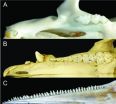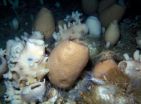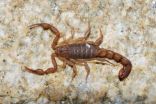(Press-News.org) Whales are mammals, but they don't look like the mammals living around us, as they have a triangular fluke for tail, no hind legs and no body hair. And inside their mouths, their teeth are unfamiliar too – being much simpler and 'peg like'. A multidisciplinary team of researchers have now married together the fossil record and the embryonic development process to investigate how the whale got its teeth.
Most mammals have four kinds of teeth, each shaped for specific tasks. In most mammals there are wedge-shaped incisors, a pointy canine, and premolars and molars with bumps and valleys that fit together like a mortar and pestle when you chew. Not all whales have teeth, but those that do, such as killer whales, have rows of simple peg like teeth, each one looking the same as the next. Whales use this spiked row of teeth to grab prey, but unlike other mammals, whales do not chew. In a new study published today in the open access journal PeerJ, Brooke Armfield and colleagues investigated the developmental processes that cause the teeth of dolphins, whales' smaller cousins, to be different, and tracked the evolutionary progression of their unique dentition across the fossil record.
Whales evolved from land mammals and so Armfield and co-workers first went to the fossil record to trace when and how whales evolved their simple teeth. The fossil record shows that, 48 million years ago, whales had the same four kinds of teeth just like most other mammals. Gradually, the teeth of whales became simpler and acquired their characteristic peg-like appearance around 30 million years ago, well after the time that they had acquired an array of adaptations for living in the water.
Next, Armfield and her colleagues explored just how teeth are shaped during development. Specific proteins in the embryo cause developing teeth to grow into certain shapes. Armfield and colleagues zeroed in on two proteins, BMP4 (Bone Morphogenetic Protein 4) and FGF8 (Fibroblast Growth Factor 8). BMP4 expression leads to teeth developing into simple prongs, and this occurs near the tip of the jaws, where the incisors form. Prior to teeth forming in the embryo, FGF8 expression in the back of the jaw leads to development of molar teeth with their complex hills and valleys in mice and other mammals.
Armfield and her co-workers studied FGF8 and BMP4 in pig embryos, relatives of whales and dolphins. Pigs have the four typical types of teeth, and, sure enough, the two proteins are distributed in the same way as they are in other mammals, showing that whales' ancestors likely had this distribution of gene expression too. Next, the authors moved on to examine dolphin embryos. Here, the pattern was different: FGF8 is present in the back part of the jaw, but BMP4 is present along the entire length of the jaw, including where FGF8 is found. The authors hypothesize that the overlapping presence of BMP4 in these new areas causes the teeth all along the jaw to be simple in shape, like incisors, and to be similar to each other. Interestingly, other researchers had shown that in mouse embryos in which BMP4 is experimentally introduced in the back of the jaw, the back teeth also take on this simplified appearance.
"It is exciting to identify a molecular change that occurred in nature and that so dramatically influenced the way in which a mammal can thrive in the ocean and to then trace the evolution of that change in the fossil record," says Armfield. "The simple shift in the location of proteins that influence tooth shape found in whales may help us to better understand how mammals evolved their complex tooth in the first place."
Says co-author Thewissen: "This shows that major changes to the design of an animal can result from small changes in early development, by simply shifting the region where an already existing protein occurs. It's a beautiful, detailed example of a small developmental change having a big effect in evolution."
INFORMATION:
Background Information
Armfield and colleagues did their experiments on museum specimen embryos of the pantropical spotted dolphin (Stenella attenuata), which is included among the toothed whales (or odontocetes). Other toothed whales are killer whales and sperm whales. Another group of whales, baleen whales (or mysticetes) have baleen plates instead of teeth as adults and these baleen whales inspired Rudyard Kipling to write "How the whale got its throat." http://www.online-literature.com/kipling/171/.
The scientists below were not involved in the work but are aware of it and can comment
* Dr. Craig Albertson, Department of Biology, University of Massachusetts, Amherst. (413) 545-2902 Albertson@bio.umass.edu.
* Dr. Annalisa Berta, Professor, Department of Biology, San Diego State University, San Diego CA, (619)594-6767. aberta@sciences.sdsu.edu.
EMBARGOED until Feb 19th 2013: 7 am EST; 12 midday UK time
Link to the Published Version of the article (quote this link in your story – the link will ONLY work after the embargo lifts): https://peerj.com/articles/24 - your readers will be able to freely access this article.
This article is published in PeerJ, a newly launched (Feb 12th) Open Access Journal. There is a separate Press Release for the PeerJ launch, at: http://bit.ly/PeerJPR02052013 (or if this link has expired, find it at: https://peerj.com/about/press/)
Competing Interests Statement (from the article): "JGM Thewissen is an Academic Editor for PeerJ. Otherwise, there are no competing interests."
Funding Statement (from the article): "NSF-DIG 0725951 (to CJV/BAA), NSF-EAR 0745543 (to JGMT), Ramanna Fellowship, Department of Science and Technology, Government of India (to SB), and Skeletal Biology Research Focus Group, Northeast OhioMedical University also provided financial support. The funders had no role in study design, data collection and analysis, decision to publish, or preparation of the manuscript."
Ethical Approval (from the article): "The following NEOUCOM protocol was reviewed and approved by this Institution's Animal Care and Use Committee (IACUC). NEOUCOM protocol NO: 07-011, Dental Development in Pigs. Type of Vertebrate Swine."
Handling Academic Editor (conducted the peer review and approved the publication): Andrew Farke, Augustyn Family Curator of Paleontology, Raymond M. Alf Museum of Paleontology
Citation to the article: Armfield et al. (2013), Development and evolution of the unique cetacean dentition. PeerJ 1:e24; DOI 10.7717/peerj.24
About PeerJ
PeerJ is an Open Access publisher of scholarly scientific content, which offers researchers a lifetime membership, for a single low price, giving them the ability to openly publish all future articles for free. The launch of PeerJ occurred on February 12th, 2013 with the publication of 30 articles. PeerJ is based in San Francisco, CA and London, UK and can be accessed at https://peerj.com/.
All works published in PeerJ are Open Access and published using a Creative Commons license (CC-BY 3.0). Everything is immediately available—to read, download, redistribute, include in databases and otherwise use—without cost to anyone, anywhere, subject only to the condition that the original authors and source are properly attributed.
PeerJ Media Resources (including logos) can be found at: https://peerj.com/about/press/
Media Contacts
For the Authors:
Dr. Brooke Armfield, Postdoctoral Fellow, University of Florida, Gainesville, +1 (352) 273.8101, barmfield26@gmail.com
Dr. J.G.M. 'Hans' Thewissen, Professor of Anatomy, Northeast Ohio Medical University, Rootstown, Ohio 44272. +1 (330)325.6295, thewisse@neomed.edu
For PeerJ:
press@peerj.com +1 415 413 4596 (PST) https://peerj.com/about/press/
Abstract (from the article)
The evolutionary success of mammals is rooted in their high metabolic rate. A high metabolic rate is sustainable thanks to efficient food processing and that in turn is facilitated by precise occlusion of the teeth and the acquisition of rhythmic mastication. These major evolutionary innovations characterize most members of the Class Mammalia. Cetaceans are one of the few groups of mammals in which precise occlusion has been secondarily lost. Most toothed whales have an increased number of simple crowned teeth that are similar along the tooth row. Evolution toward these specializations began immediately after the time cetaceans transitioned from terrestrial-to-marine environments. The fossil record documents the critical aspects of occlusal evolution of cetaceans, and allows us to pinpoint the evolutionary timing of the macroevolutionary events leading to their unusual dental morphology among mammals. The developmental controls of tooth differentiation and tooth number have been studied in a few mammalian clades, but nothing is known about how these controls differ between cetaceans and mammals that retain functional occlusion. Here we show that pigs, a cetacean relative with regionalized tooth morphology and complex tooth crowns, retain the typical mammalian gene expression patterns that control early tooth differentiation, expressing Bmp4 in the rostral (mesial, anterior) domain of the jaw, and Fgf8 caudally (distal, posterior). By contrast, dolphins have lost these regional differences in dental morphology and the Bmp4 domain is extended into the caudal region of the developing jaw. We hypothesize that the functional constraints underlying mammalian occlusion have been released in cetaceans, facilitating changes in the genetic control of early dental development. Such major developmental changes drive morphological evolution and are correlated with major shifts in diet and food processing during cetacean evolution.
How the whale got its teeth
Scientists explore the development of the unique dentition of 'toothed whales'
2013-02-19
ELSE PRESS RELEASES FROM THIS DATE:
Stillbirth in Inuit and First Nations women higher than for non-Aboriginal residents
2013-02-19
Stillbirth rates in First Nations and Inuit populations in Quebec are higher than in the general population, especially in late gestation and at term, found a new study in CMAJ (Canadian Medical Association Journal).
"Aboriginal populations in Canada [First Nations and Inuit] rank at the top of the list of disadvantaged groups with the highest rates of stillbirth in the Western world," writes Dr. Nathalie Auger, Institut national de santé publique du Québec, with coauthors. Rates are 2 times those of the non-Aboriginal population.
Researchers looked at data on 9983 ...
Unplanned hospitalization more likely in people with several illnesses, mental health conditions
2013-02-19
People with multiple illnesses are much more likely to be admitted to hospital unexpectedly, and mental health issues and economic hardship further increase the likelihood, according to a study in CMAJ (Canadian Medical Association Journal).
"We provide strong evidence that physical multimorbidity substantially affects the use of acute hospital services, including admissions considered potentially preventable through management of optimal primary care," writes Dr. Rupert Payne, Cambridge Centre for Health Services Research, University of Cambridge, Cambridge, United Kingdom. ...
There's room for improvement in women's heart disease awareness
2013-02-19
The number of women aware that heart disease is the leading cause of death has nearly doubled in the last 15 years, but that knowledge still lags in minorities and younger women, according to a new study in the American Heart Association journal Circulation.
Researchers comparing women's views about heart disease in 1997 and today, found:
In 2012, 56 percent of women identified heart disease as the leading cause of death compared with 30 percent in 1997.
In 1997, women were more likely to cite cancer than heart disease as the leading killer (35 percent versus 30 ...
Data paper describes Antarctic biodiversity data gathered by 90 expeditions since 1956
2013-02-19
A new peer-reviewed data paper offers a comprehensive, open-access collection of georeferenced biological information about the Antarctic macrobenthic communities. The term macrobenthic refers to the visible-for-the-eye organisms that live near or on the sea bottom such as echinoderms, sponges, ascidians, crustaceans. The paper will help in coordinating biodiversity research and conservation activities on species living near the ocean bottom of the Antarctic.
The data paper "Antarctic macrobenthic communities: A compilation of circumpolar information", published in the ...
Phosphorus starvation linked to symptoms of citrus disease Huanglongbing in new study
2013-02-19
The citrus disease Huanglongbing (HLB), meaning "yellow shoot disease" in Chinese and also called citrus greening in English-speaking countries, is the most destructive disease threatening the citrus industry worldwide. Powerful diagnostic tools and management strategies are desired to control it. A new study, 'Small RNA profiling reveals phosphorus deficiency as a contributing factor in symptom expression for citrus Huanglongbing disease', published online today (Friday) in the journal Molecular Plant profiled small Ribonucleic Acids (sRNAs) from both diseased and healthy ...
Moffitt researchers say silencing of retinoblastoma gene regulates differentiation of myeloid cells
2013-02-19
Researchers at the Moffitt Cancer Center have found a potential mechanism by which immune suppressive myeloid-derived suppressor cells can prevent immune response from developing in cancer. This mechanism includes silencing the tumor suppressor gene retinoblastoma 1 or Rb1. Their data explains a new regulatory mechanism by which myeloid-derived suppressor cells are expanded in cancer.
Their study appeared in a recent issue of Nature Immunology.
According to the authors, two kinds of myeloid-derived suppressor cells - monocytic M-MDSCs and granulocytic PMN-MDSCs - regulate ...
New scorpion discovery near metropolitan Tucson, Arizona
2013-02-19
A new species of scorpion, Vaejovis brysoni, was found in the Santa Catalina Mountains in southern Arizona. Another scorpion of the same group also inhabits this mountain range, making this the first documented case of two vorhiesi group species distributed on the same mountain. The study was published in the open access, peer-reviewed journal Zookeys.
These mountains overlook the city of Tucson, Arizona. Amazingly, in the 21st century, there are still new species to be discovered right here in the United States. What is even more surprising is that the new species was ...
Using mouthrinse reduces plaque and gingivitis more than toothbrushing alone
2013-02-19
CHICAGO (Feb. 19, 2013)—New research published in the January/February 2013 issue of General Dentistry, the peer-reviewed clinical journal of the Academy of General Dentistry (AGD), indicates that the use of a germ-killing mouthrinse in addition to regular toothbrushing can significantly reduce plaque and gingivitis, more so than brushing alone.
"It's simple—mouthrinses can reach nearly 100 percent of the mouth's surfaces, while brushing focuses on the teeth, which make up only 25 percent of the mouth," says Christine A. Charles, RDH, BS, lead author of the study and ...
Genetic signs of alcoholism in women studied for the first time
2013-02-19
This press release is available in Spanish.
Research done at the UPV/EHU-University of the Basque Country has determined the frequency of genetic variants linked to alcoholism for the Spanish population, and its incidence not only in individuals with a high level of alcohol intake, but also in individuals with alcohol dependence. Furthermore, the broad presence of women in the sample has made it possible, for the first time, to associate some of these genetic variants with a high level of alcohol intake in women. The results have been published in various top, international ...
Coming to a smartphone near you: Personalized experiences
2013-02-19
CHESTNUT HILL, MA (February 19, 2013) – Say au revoir to the concierge.
The proliferation of technology focused on finding the best tickets, the hottest restaurants or the next flight out of town may mean it's time to bid adieu to the concierge and other traditional service information gatekeepers, according to new research.
Face-to-face interactions with front desk clerks and concierges are not essential for personalized service, and increasingly these encounters are being substituted with Smartphone apps and other automated service systems, according to a study in ...
LAST 30 PRESS RELEASES:
Numbers in our sights affect how we perceive space
SIMJ announces global collaborative book project in commemoration of its 75th anniversary
Air pollution exposure and birth weight
Obstructive sleep apnea risk and mental health conditions among older adults
How talking slows eye movements behind the wheel
The Ceramic Society of Japan’s Oxoate Ceramics Research Association launches new international book project
Heart-brain connection: international study reveals the role of the vagus nerve in keeping the heart young
Researchers identify Rb1 as a predictive biomarker for a new therapeutic strategy in some breast cancers
Survey reveals ethical gaps slowing AI adoption in pediatric surgery
Stimulant ADHD medications work differently than thought
AI overestimates how smart people are, according to HSE economists
HSE researchers create genome-wide map of quadruplexes
Scientists boost cell "powerhouses" to burn more calories
Automatic label checking: The missing step in making reliable medical AI
Low daily alcohol intake linked to 50% heightened mouth cancer risk in India
American Meteorological Society announces Rick Spinrad as 2026 President-Elect
Biomass-based carbon capture spotlighted in newly released global climate webinar recording
Illuminating invisible nano pollutants: advanced bioimaging tracks the full journey of emerging nanoscale contaminants in living systems
How does age affect recovery from spinal cord injury?
Novel AI tool offers prognosis for patients with head and neck cancer
Fathers’ microplastic exposure tied to their children’s metabolic problems
Research validates laboratory model for studying high-grade serous ovarian cancer
SIR 2026 delivers transformative breakthroughs in minimally invasive medicine to improve patient care
Stem Cell Reports most downloaded papers of 2025 highlight the breadth and impact of stem cell research
Oxford-led study estimates NHS spends around 3% of its primary and secondary care budget on the health impacts of heat and cold in England
A researcher’s long quest leads to a smart composite breakthrough
Urban wild bees act as “microbial sensors” of city health.
New study finds where you live affects recovery after a hip fracture
Forecasting the impact of fully automated vehicle adoption on US road traffic injuries
Alcohol-related hospitalizations from 2016 to 2022
[Press-News.org] How the whale got its teethScientists explore the development of the unique dentition of 'toothed whales'



